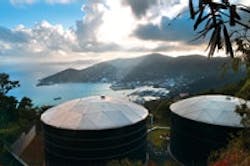Creating an Economical Drinking Water Supply
About the author: Kristan Kirsh is marketing communications director for Energy Recovery. Kirsh can be reached at [email protected] or 510.746.5012.
Every year, the 24,000 residents of Tortola watch the island’s numbers swell, as more than 800,000 visitors arrive by cruise ship and air to descend upon its white sand beaches. As the largest and most populated of the British Virgin Islands, Tortola depends on these vacationers year-round; 92% of the island’s gross domestic product comes from tourism alone.
The tourism business is one that the people of Tortola have worked diligently to grow. Between 2004 and 2010, the island nation increased its hotel room capacity by 33%, according to a report by the Caribbean Centre for Money & Finance. Over the past 20 years, the number of visitors to the island has more than tripled.
While a boon to the local economy, the growing influx of tourists places a heavy burden on the island’s infrastructure and resources, including its freshwater supply. Like many island nations, Tortola lacks natural aquifers and, given its mountainous terrain, large-scale water collection and storage are hardly feasible. That is why the island historically has depended almost entirely on desalination, in the form of seawater reverse osmosis (SWRO), to supply drinking water to residents and visitors alike.
The island’s three existing desalination facilities, however, are small, aging and becoming increasingly expensive to operate. Power costs on the island are high, and the desalination plants’ less-than-optimal efficiency and deteriorating condition pose a threat to the island’s environment and marine life. Additionally, without a secure year-round supply, residents’ lives and tourists’ experiences could be largely impacted by inadequate drinking water supplies, which could affect the local economy.
Desalination Solution
To address these concerns, the British Virgin Islands’ government contracted with Biwater, a U.K.-based engineering, water and wastewater business, to design a new, energy-efficient, 10,400 cu-meter-per-day desalination plant for the island—big enough to produce freshwater for more than 75% of its residents, in addition to drinking water provisions for cruise ships, local businesses and industrial entities. Under the same contract, Biwater is designing and constructing two wastewater treatment facilities that will provide water treatment services for the local population and protect the marine environment against degradation.
Ensuring Energy Efficiency
In designing the SWRO plant, energy efficiency was high on the list of priorities. The reason was simple: Energy costs can, in some cases, account for almost half of the cost of turning seawater into drinking water.
To build in maximum efficiency, designers looked to what are traditionally the greatest consumers of energy in an SWRO plant: the high-pressure pumps used to deliver feed seawater through the pretreatment system to the plant’s RO train. For the Tortola plant, they identified a packaged energy recovery solution that would reduce the power consumed by these high-pressure pumps by as much as 60%.
The solution, known as PowerPlay, consists of an energy recovery device (ERD) known as a PX pressure exchanger, working in combination with an AquaBold high-pressure pump. Together, they reduce the amount of pressure and flow energy the high-pressure pump must deliver.
How It Works
Designed by Energy Recovery, the PX pressure exchanger is a rotary-type isobaric device that recovers most of the pressure needed to operate the high-pressure pumps and transfers it back to the SWRO feed stream for reuse. Its efficiency is greater than 95% under most SWRO process conditions, with efficiency loss that does not exceed 5%.
The ERD works by transferring pressure from the high-pressure membrane concentrate to the treated low-pressure seawater when the two streams are put in direct, momentary contact within the PX rotor.
This ceramic rotor is fit into a ceramic sleeve between two ceramic end covers that create an almost frictionless hydrodynamic bearing. Half of the rotor ducts are exposed to high pressure, and half are exposed to the low-pressure stream. Rotor ducts, which are turned by the flow, pass a sealing area that separates high- and low-pressure circuits.
With no pistons or physical barriers, the device is designed so the interface between the concentrate and the seawater in a duct never reaches the end of the rotor before the duct is sealed. When the rotor is not spinning, flow passes directly through the device, making PX device operation during startup and shutdown virtually automatic.
Because it is a “plug and play” solution, the PowerPlay was deployed quickly. Later this year, when the facility is commissioned, it will help deliver fast payback as well as low-cost, high-quality water.
The Result
Once operational, the new Biwater Tortola plant will supply island residents and tourists with up to 10,400 cu meters of high-quality, affordable potable water per day. The AquaBold PowerPlay solution is helping to reduce the overall power consumed in the plant by up to 60%, compared with plants with no ERD, and by 15% to 20%, compared with plants with other ERD technologies. In the Tortola plant, that is estimated to result in savings of up to 8.2 million KWh, or $8.2 million, per year. By lowering energy consumption, the plant also is projected to save 4,862 metric tons of CO2 emissions annually, or roughly the equivalent of taking 1,300 cars off the road.
Download: Here
